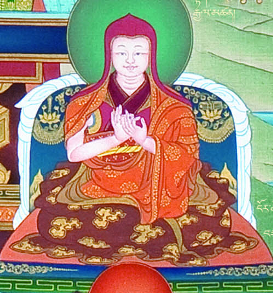Ngor: Difference between revisions
Jump to navigation
Jump to search
No edit summary |
m (Oh we had a link already at the Ngor Monastery page.) |
||
| (6 intermediate revisions by 3 users not shown) | |||
| Line 1: | Line 1: | ||
'''Ngor''' ([[Wyl.]] ''ngor'') — one of the two main subschools of the [[Sakya]] tradition, founded by [[Ngorchen Kunga Zangpo]] (1382-1456). It is characterized by its rigorous discipline and knowledge of the [[tantra]]s. [[Luding Khen Rinpoche]], one of the sons of [[Jetsün Kushok Chimey Luding]], is the present head of this school. | [[File:Ngorchen.png|thumb|[[Ngorchen Kunga Zangpo]]]] | ||
'''Ngor''' (Tib. ངོར་, [[Wyl.]] ''ngor'') — one of the two main subschools of the [[Sakya]] tradition, founded by [[Ngorchen Kunga Zangpo]] (1382-1456). It is characterized by its rigorous discipline and knowledge of the [[tantra]]s. It is famous for the so-called '[[Seven mandalas of Ngor]]': [[Guhyasamaja]], [[Hevajra]], [[Chakrasamvara]], [[Vajrayogini]], [[Vajrabhairava]], [[Sarvavidya]] and [[Mahakala]]. | |||
[[Luding Khen Rinpoche]], one of the sons of [[Jetsün Kushok Chimey Luding]], is the present head of this school. | |||
==Further Reading== | ==Further Reading== | ||
| Line 6: | Line 9: | ||
==Internal Links== | ==Internal Links== | ||
*[[Ngor Monastery]] | *[[Ngor Monastery]] | ||
*[[Throneholders of Ngor Monastery]] | |||
*[[Tsar]] | |||
[[Category:Sakya]] | [[Category:Sakya]] | ||
[[Category:Schools and Lineages]] | [[Category:Schools and Lineages]] | ||
Latest revision as of 01:26, 28 February 2020

Ngor (Tib. ངོར་, Wyl. ngor) — one of the two main subschools of the Sakya tradition, founded by Ngorchen Kunga Zangpo (1382-1456). It is characterized by its rigorous discipline and knowledge of the tantras. It is famous for the so-called 'Seven mandalas of Ngor': Guhyasamaja, Hevajra, Chakrasamvara, Vajrayogini, Vajrabhairava, Sarvavidya and Mahakala.
Luding Khen Rinpoche, one of the sons of Jetsün Kushok Chimey Luding, is the present head of this school.
Further Reading
- Ronald M. Davidson, 'The Ṅor-pa Tradition' in Wind Horse, Asian Humanities Press, 1981, pp. 79-98